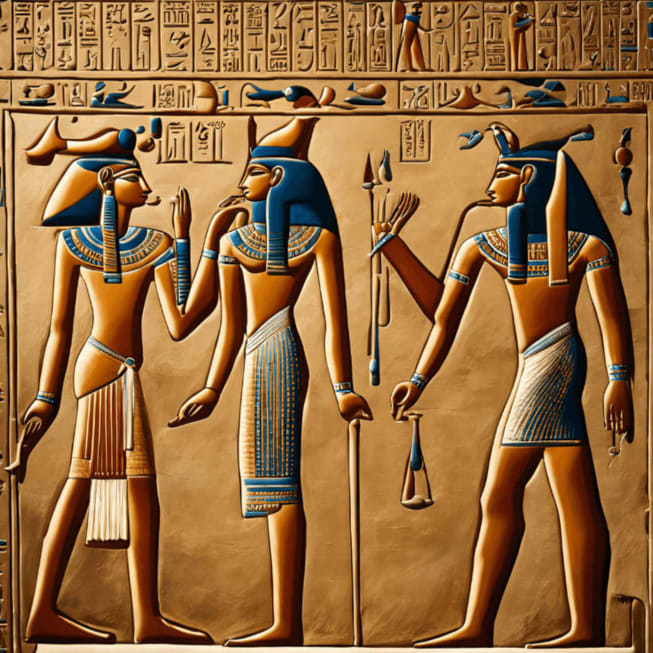THE PLATONIC SOLIDS • The Geometry of Physical Matter

The Platonic Solids, named for the Greek philosopher Plato who reintroduced them to the Western world, are far older than Classical Greece. These perfect geometric forms were understood by ancient civilisations thousands of years earlier.
Archaeological finds in Scotland reveal carved stone spheres dating to around 34,000 BCE, bearing facets aligned with the five perfect polyhedra. Later, mysterious Roman dodecahedra — twelve-faced bronze artefacts found across Britain and Gaul from the 2nd to 4th centuries AD — further attest to a long-held reverence for sacred geometry. To the ancients, geometry was not an abstraction but a divine language — the bridge between spirit and matter through which creation takes form.
Modern science now confirms what ancient wisdom has long taught: these shapes represent the structural foundation of all physical matter. A Platonic Solid is a perfectly regular polyhedron — each face identical, each edge equal, each angle harmonious, and every vertex fitting precisely within a sphere. These five forms define the energetic architecture of space and the symmetry through which vibration becomes form. The same geometry can be seen throughout nature, from crystalline lattices and pollen grains to the molecular architecture of viruses and the atomic structure of matter itself.
The Five Archetypal Forms of Creation
- Tetrahedron — Fire
Composed of four equilateral triangles, the Tetrahedron embodies the element of Fire and the principle of transformation. It ignites will, catalyses creativity, and radiates direction and clarity. In meditation, visualising a Tetrahedron within the solar plexus awakens focus and dynamism. In nature, it manifests within silicon and carbon tetrahedra — the structural basis of quartz, diamond, and DNA geometry. - Cube — Earth
With six square faces, the Cube symbolises grounding, stability, and form. It represents the architecture of embodiment and the harmonisation of matter. Holding or contemplating this form anchors energy, bringing balance and resilience. Crystals such as Pyrite and Fluorite naturally grow in cubic symmetry, while the Cube’s ratios are found in temple foundations and sacred architecture designed for energetic stability and acoustic precision. - Octahedron — Air
The Octahedron, formed of eight equilateral triangles, represents the element of Air and the principle of balance, breath, and communication. It aligns the Heart Chakra, harmonising opposites and expanding awareness through the equilibrium of giving and receiving. In mineral form, Magnetite often crystallises as an octahedron, its dual polarity mirroring the structure’s inherent symmetry. This shape also governs airflow and magnetic alignment within architectural domes and planetary fields. - Icosahedron — Water
With twenty triangular faces, the Icosahedron corresponds to Water, emotion, adaptability, and fluid intelligence. It carries the frequency of movement and flow. Meditating upon this shape helps restore flexibility, emotional balance, and creative freedom. In nature, viral shells and radiolaria adopt icosahedral geometry, expressing how life itself relies on this form for efficient containment and energetic coherence. The same geometric logic guides the design of modern domes and aerospace structures that balance strength with lightness. - Dodecahedron — Aether
The Dodecahedron, with twelve pentagonal faces, is aligned with Aether or Spirit — the unifying field that connects all dimensions. It symbolises divine order, unity, and the quantum field of consciousness through which thought becomes manifestation. Its presence can be felt in the dodecahedral geometry of certain Garnets and within the molecular lattice of buckminsterfullerene (C₆₀). Ancient temples and Gothic cathedrals were proportioned using dodecahedral ratios to amplify resonance and connect sacred space with celestial harmony.
Together these five forms represent the elemental architecture of existence. Their interplay defines the underlying matrix through which energy, matter, and consciousness are interwoven. This sacred mathematics forms the living foundation explored more deeply in Metatron’s Cube — The Foundation of Physical Matter, where all five shapes are shown to emerge from one universal pattern.
Ancient Knowledge and the Sacred Science of Form
Robert Edward Grant, Theresa Bullard, and Robert J. Gilbert each describe sacred geometry as a living code through which divine intelligence organises creation. Their studies show that geometric proportion governs everything from atomic structure to biological growth and planetary motion. Physicist Robert J. Moon extended this principle into modern science, proposing an atomic model based on nested Platonic Solids, revealing that the nucleus of every element mirrors these same forms — a relationship explored in The Periodic Table — The Sacred Geometry of Chemistry.
Ancient builders incorporated these geometries into their temples and monuments to align structure with cosmic order. The Great Pyramid of Giza, for example, is designed upon harmonic ratios derived from the golden mean and the square-based geometry of the Cube and Octahedron. Megalithic sites across Europe, Indian Vedic temples, and Mayan pyramids were constructed using geometric templates that align with celestial coordinates, allowing energy to flow coherently through stone, sound, and light. This same principle of resonance appears again in Gothic cathedrals, where dodecahedral and octahedral ratios govern the curvature of domes and the spacing of columns, transforming architecture into a living instrument of frequency.
Geometry in Modern Engineering and Technology
Platonic geometry continues to underpin modern science and technology. The spherical implosion systems used in nuclear physics rely on polyhedral symmetry to achieve perfectly uniform compression — a direct application of icosahedral and dodecahedral balance. Geodesic domes and aerospace frameworks use similar logic to distribute stress evenly while maintaining structural efficiency. In molecular chemistry, carbon atoms form dodecahedral cages known as fullerenes, while the arrangement of water molecules often reflects tetrahedral bonding. Even in contemporary data storage, magnetic field design, and antenna engineering, Platonic ratios determine efficiency and coherence of transmission.
Integration Through Quantum Vortex Geometry
In Sacred Geometry and Orgonite — The Geometry of Quantum Vortex Orgone, these universal proportions are not merely studied but embodied. Each Quantum Vortex creation is structured according to the same harmonic principles as the Platonic Solids, using magnetic and non-magnetic metals, piezoelectric crystals, and precise geometric layering to anchor higher coherence into physical form. This approach transforms sacred geometry into functional energetic technology, bridging the invisible with the tangible.
To experience these principles expressed in form, explore the Quantum Vortex Store, where each pyramid, charging plate, and harmoniser is designed as a three-dimensional embodiment of the Platonic code — harmonising energy, restoring coherence, and awakening remembrance of the cosmic order.
Sacred Geometry of Quantum Vortex Orgone
As with all forms of energetic practice, including the use of orgones and crystals, the properties described are intended for informational and spiritual purposes only and should complement — not replace — professional medical advice, diagnosis, or treatment.

Online Store
View our current selection of Orgones and crystals to elevate your Spirit and Space

Quantum Vortex Orgone
Learn about Quantum Vortex Orgones, a combination of science, alchemy and art

Blog
Check our Blog for the latest informative updates
